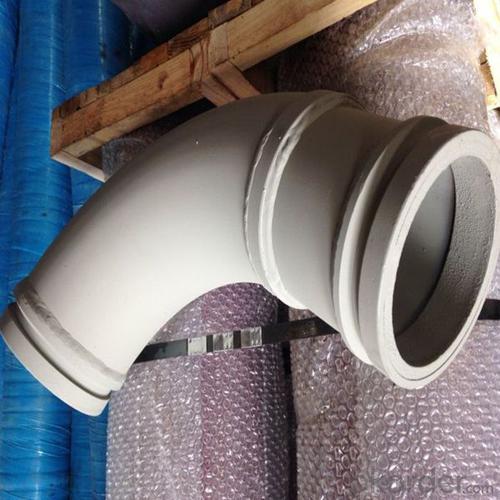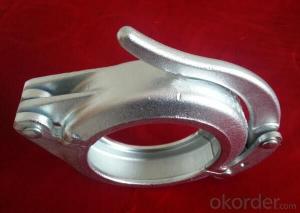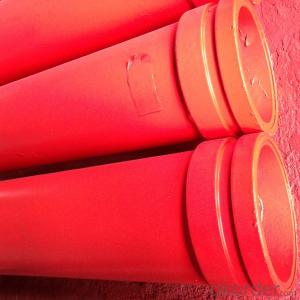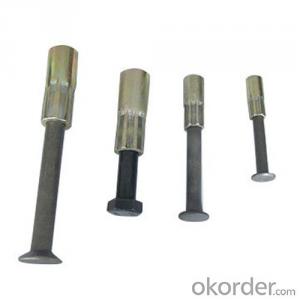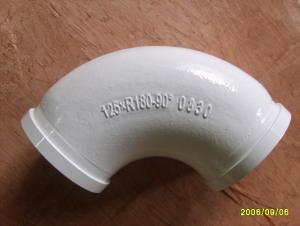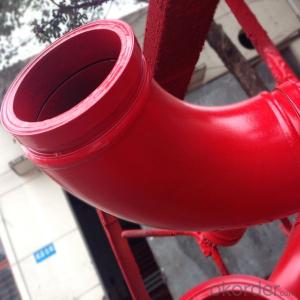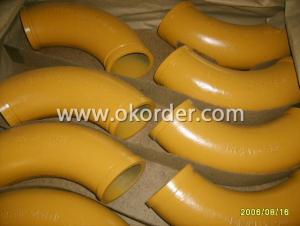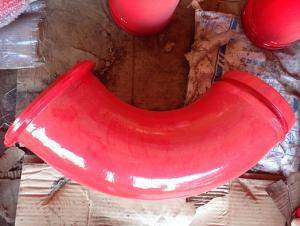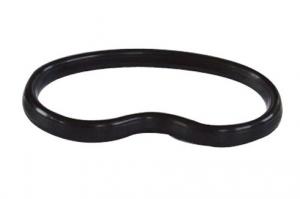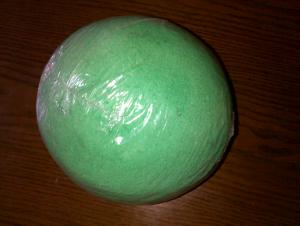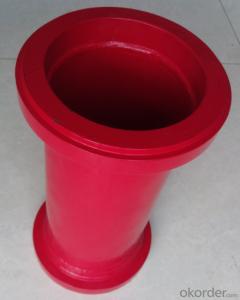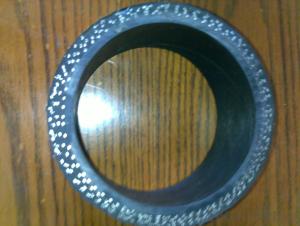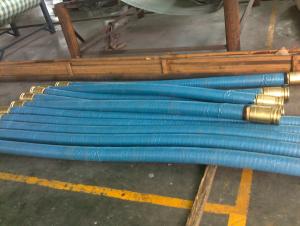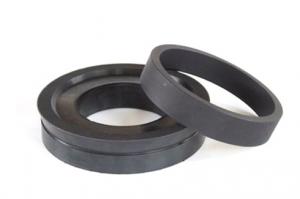Concrete Pumps Spare Parts Elbow 90 DEG EXT 100MM
- Loading Port:
- Tianjin
- Payment Terms:
- TT OR LC
- Min Order Qty:
- 20 pc
- Supply Capability:
- 1000 pc/month
OKorder Service Pledge
OKorder Financial Service
You Might Also Like
Product Description:
The Concrete Pumps Spare Parts Elbow 90 DEG EXT 100MM normally made by special MN13-4, to make sure the quanlity of elbows according to customer’s requests we usually keep the content of MN strictly over 15%, it will have a longer life as well, package will be in plywood box or cartons and put into container.
Scope of Application of the Goods
The Concrete Pumps Spare Parts Elbow 90 DEG EXT 100MM is a concrete pumps parts for combined use with other concrete parts in for concrete pumps and truck pumps. It can be widely used in the construction of various types of concrete structures like industrial and civil buildings, bridges, roads, and other types of infrastructure.
This seals can only be used in Schwing type concrete pumps and truck pumps as well, but not in any other operations.
Product Advantages:
OKorder's Concrete Pumps Spare Parts Elbow 90 DEG EXT 100MM Channels are durable, strong, and safety.
Main Product Features:
· Premium quality
· Prompt delivery & seaworthy packing (5-10 days)
Reliable performance
Easy to weld
High safety.
· Professional Service
· Competitive pricing
Measuring of wall thickness from the outside
Low purchase cost
Specifications:
R275 90DEG EXT 100MM twin wall layers
Capacity Life: 50,000 cbm
FAQ:
Q1: How long about delivery time Concrete Pumps Spare Parts Elbow 90 DEG EXT 100MM ?
A1: Normally we keep the raw materials for old customers and sometime we also keep stock products to make sure delivery time in any emergency cases.
Q2: How do we guarantee the quality of our Concrete Pumps Spare Parts Elbow 90 DEG EXT 100MM ?
A2: We have established an advanced quality management system which conducts strict quality tests at every step, from raw materials to the final product. At the same time, we provide extensive follow-up service assurances as required.
Q3: How soon can we receive the product after purchase?
A3: Within three days of placing an order, we will book the vessel for goods. The specific shipping date is dependent upon international and government factors, but is typically 7 to 30 workdays.
Q4: If we can produce some goods according to customers request?
A4: Yes, we can produce Elbow 90 DEG EXT 100MM according to the difference country situations to make it suitable to the market and customers. We have very professional technical team to make the design for porduction of seals.
Q5: How to make a quick resolution for after service?
A5: OKorder and our manufacture both have overseas branches all-around of world.
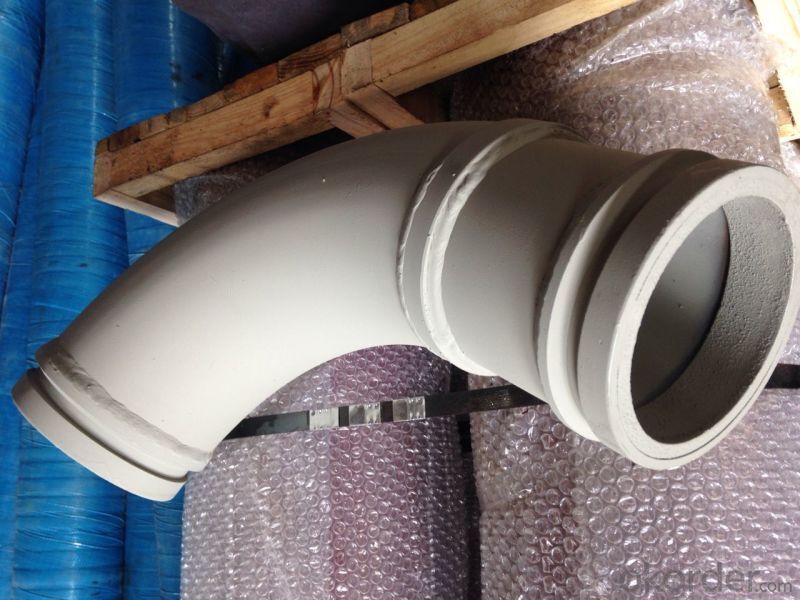
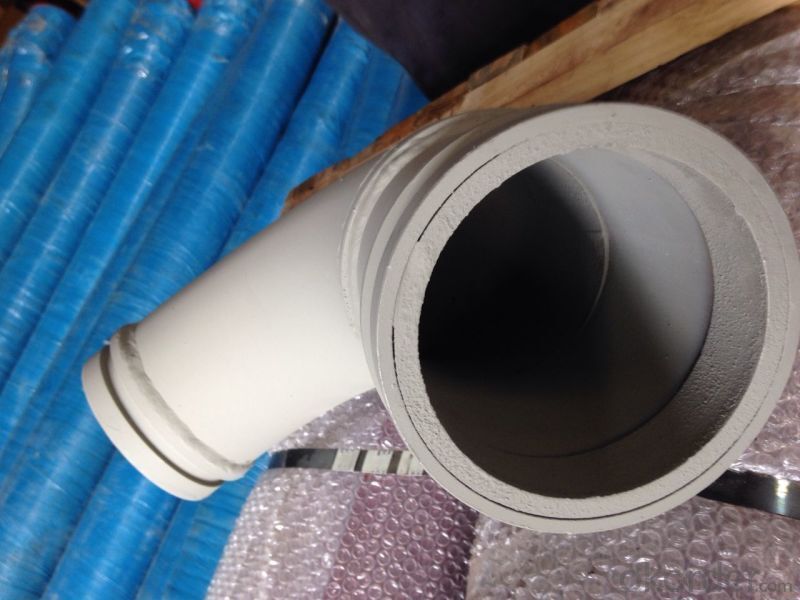
- Q: Are there any specific training or certifications required for handling and installing concrete pump spare parts?
- Handling and installing concrete pump spare parts necessitates specific training and certifications. Given the specialized nature of the equipment and the potential risks involved, individuals must undergo appropriate training and obtain relevant certifications. One must first acquire a comprehensive understanding of concrete pumps' functioning and components. This knowledge can be gained through extensive training programs offered by equipment manufacturers, industry associations, and vocational schools. These programs cover topics such as pump operation, maintenance, troubleshooting, and safety protocols. Furthermore, depending on jurisdiction or industry standards, specific certifications may be necessary. For instance, the American Concrete Pumping Association (ACPA) provides the ACPA Operator Certification, which requires individuals to demonstrate their proficiency in concrete pumping equipment, including the handling and installation of spare parts. Obtaining these certifications ensures that individuals possess the necessary knowledge and skills to handle and install concrete pump spare parts safely and efficiently. It also aids in complying with industry regulations and standards. It is crucial to note that the specific training and certification requirements may vary based on the region, industry, and type of concrete pump utilized. Therefore, it is advisable to consult local regulations and industry guidelines to ensure adherence to the requisite training and certification requirements for handling and installing concrete pump spare parts.
- Q: Are there any specific guidelines for the selection and installation of hydraulic components in concrete pump spare parts?
- Concrete pump spare parts have specific guidelines for the selection and installation of hydraulic components. When choosing these components, it is important to consider factors like the maximum operating pressure, flow rate, and compatibility with the existing hydraulic system. First and foremost, it is crucial to ensure that the selected hydraulic components can handle the maximum operating pressure of the concrete pump. This includes components such as hydraulic cylinders, valves, and pumps. To ensure their durability and longevity, it is advisable to choose components with a higher pressure rating than that of the concrete pump's operating pressure. Additionally, the flow rate of the hydraulic components must match the requirements of the concrete pump system. Hydraulic pumps and valves need to provide sufficient flow to effectively operate the concrete pump. Factors such as the size of the concrete pump, desired output capacity, and specific pumping requirements should be taken into consideration. Furthermore, compatibility with the existing hydraulic system is vital for the smooth operation of the concrete pump. It is important to select hydraulic components that are compatible with the system in terms of fittings, connections, and overall design. Seeking guidance from the manufacturer's guidelines or professional advice is recommended when selecting and installing hydraulic components in concrete pump spare parts. Moreover, proper installation is essential to ensure optimal performance and safety of the hydraulic components. Following the manufacturer's installation instructions and guidelines is highly recommended. The installation process should include proper alignment, secure mounting, and appropriate sealing of the components to prevent any leaks or failures. In conclusion, there are specific guidelines for selecting and installing hydraulic components in concrete pump spare parts. Considering factors like maximum operating pressure, flow rate, compatibility, and following proper installation procedures can help ensure the efficient and safe operation of the concrete pump system.
- Q: What is the difference between concrete pump and ground pump?
- Ground pump only conveying function, the price is cheaper, and now are used to transport mixing machine, the ground pump is a bit uneconomical
- Q: What are the indications of a worn-out concrete pump clamp?
- A worn-out concrete pump clamp may exhibit several indications that replacement is necessary. These indications commonly include: 1. Leakage: In the event of leakage around the clamp area while operating the concrete pump, it could signify a worn-out clamp. This leakage may be a result of a faulty seal or gasket, which can no longer establish a secure and tight connection between the pump and the hose. 2. Vibrations and rattling: Excessive vibrations and rattling during the pumping process can be attributed to a worn-out clamp. This can occur when the clamp fails to firmly hold the hose in place, resulting in movement and instability. 3. Difficulty in tightening: If you encounter increasing difficulty in properly tightening the clamp, it may indicate wear-out. Over time, the components of the clamp may deteriorate, making it more challenging to achieve a secure and tight connection. 4. Visual damage: Inspect the clamp for visible signs of damage, such as cracks, dents, or corrosion. These physical damages can compromise the clamp's functionality, potentially leading to leaks or instability. 5. Excessive wear and tear: If you have been utilizing the same concrete pump clamp for an extended period without replacement, it is advisable to regularly inspect it for signs of excessive wear and tear. This may include worn-out or missing bolts, a deformed clamp body, or any other visible signs of deterioration. Promptly addressing any indications of a worn-out concrete pump clamp is crucial to ensure the safety and efficiency of pumping operations. If any of these signs are observed, it is recommended to seek professional consultation or replace the clamp to prevent potential accidents or disruptions in the concrete pumping process.
- Q: What are the functions of concrete pump truck?
- Concrete large transport equipment, used in high-rise buildings, high-speed, overpass and other large concrete works of concrete transmission.
- Q: What are the different types of concrete pump control system sensors?
- There are several different types of sensors used in concrete pump control systems to ensure smooth and efficient operation. These sensors are designed to monitor various aspects of the pump's performance and provide real-time feedback to the control system. Some of the common types of sensors used in concrete pump control systems include: 1. Pressure Sensors: These sensors are used to measure the pressure of the concrete being pumped. They are typically installed in the discharge line and help to ensure that the pump is operating within the desired pressure range. Pressure sensors are crucial in preventing over-pressurization and potential damage to the pump or pipeline. 2. Flow Sensors: Flow sensors are employed to measure the flow rate of the concrete. By monitoring the volume of concrete passing through the system per unit of time, these sensors enable the control system to regulate the speed and output of the pump accordingly. Flow sensors help in maintaining a consistent and controlled flow of concrete during pumping operations. 3. Level Sensors: Level sensors are utilized to monitor the level of concrete in the hopper or storage tank. These sensors provide information to the control system about the concrete volume, ensuring that the pump is not running dry or becoming overloaded. By maintaining the appropriate level of concrete in the hopper, level sensors help to prevent pump cavitation or blockages. 4. Proximity Sensors: Proximity sensors are used to detect the position of various moving parts in the pump system, such as the boom or outriggers. They provide feedback to the control system, ensuring that the pump operates safely and avoids any potential collisions or obstructions. Proximity sensors play a crucial role in preventing accidents and protecting both the equipment and personnel. 5. Temperature Sensors: Temperature sensors are employed to monitor the temperature of the concrete mix. These sensors help to ensure that the concrete remains within the desired temperature range during pumping, as extreme temperatures can affect the workability and curing process. By maintaining the optimal concrete temperature, temperature sensors contribute to the quality of the final product. Overall, these sensors work together to provide precise and reliable feedback to the control system, allowing for efficient and safe operation of the concrete pump. By continuously monitoring and adjusting various parameters, the sensors help to optimize pumping performance and enhance the overall productivity of concrete placement projects.
- Q: How do I ensure the compatibility of mechanical components in concrete pump spare parts?
- To ensure the compatibility of mechanical components in concrete pump spare parts, there are several key steps you can follow: 1. Identify the specific make and model of your concrete pump: Different concrete pumps may have varying designs and specifications, so it is crucial to know the exact make and model of your pump. This information will help you determine the compatible spare parts for your specific pump. 2. Consult the manufacturer's documentation: Review the manufacturer's documentation, including the user manual and parts catalog, to understand the recommended spare parts for your concrete pump. These documents often provide detailed information on the compatibility of various mechanical components. 3. Seek advice from the manufacturer or authorized dealers: If you are unsure about the compatibility of certain mechanical components, it is best to reach out to the manufacturer or authorized dealers. They have extensive knowledge and experience with their products and can provide guidance on selecting compatible spare parts. 4. Consider OEM (Original Equipment Manufacturer) parts: OEM parts are specifically designed and manufactured by the original equipment manufacturer. Using OEM parts ensures the highest level of compatibility and reliability. While they may be slightly more expensive than aftermarket alternatives, they often provide better performance and longer service life. 5. Check for standardized sizing and specifications: Mechanical components, such as seals, gaskets, and bearings, often have standardized sizes and specifications. Verify that the spare parts you are considering match these standardized measurements to ensure compatibility. 6. Conduct thorough research and comparison: Before purchasing spare parts, research different suppliers and compare their offerings. Look for reputable suppliers who specialize in concrete pump spare parts and have a track record of delivering high-quality, compatible components. 7. Perform compatibility tests: If you are uncertain about the compatibility of a particular mechanical component, consider conducting compatibility tests. This can involve installing the spare part in your concrete pump and verifying its fit, function, and performance. If possible, consult with a qualified mechanic or technician to assist you in conducting these tests. By following these steps, you can ensure the compatibility of mechanical components in concrete pump spare parts, minimizing the risk of compatibility issues and ensuring the smooth operation and maintenance of your concrete pump.
- Q: How do I properly maintain and replace rubber pistons in concrete pump spare parts?
- Maintaining and replacing rubber pistons in concrete pump spare parts is crucial for the efficient operation of the pump and to ensure a longer lifespan of the equipment. Here are some steps to properly maintain and replace rubber pistons in concrete pump spare parts: 1. Regular Inspection: It is important to inspect the rubber pistons regularly to identify any signs of wear or damage. Look for cracks, tears, or any other visible signs of deterioration. 2. Cleaning: Before replacing the rubber pistons, make sure to thoroughly clean the area around the pistons. Remove any dirt, debris, or concrete residue that may be present. This will help prevent contamination and ensure a proper fit for the new pistons. 3. Proper Lubrication: Apply a suitable lubricant to the rubber pistons to ensure smooth operation and reduce friction. This will help prolong the life of the pistons and prevent premature wear. 4. Correct Installation: When replacing the rubber pistons, ensure they are properly installed according to the manufacturer's instructions. Use the correct tools and techniques to avoid damaging the pistons or other components of the pump. 5. Quality Replacement Parts: Always use high-quality replacement rubber pistons from reputable suppliers. Inferior quality pistons may not perform as well and could result in frequent replacements or damage to the pump. 6. Regular Maintenance: Implement a regular maintenance schedule for your concrete pump, including the rubber pistons. This can include cleaning, lubrication, and inspection of the pistons to identify any signs of wear or damage before they become major issues. 7. Training and Expertise: Ensure that the person responsible for maintaining and replacing the rubber pistons has the necessary training and expertise. This will help ensure the job is done correctly and minimize the risk of damage to the pump or injury to personnel. By following these steps, you can properly maintain and replace rubber pistons in concrete pump spare parts, ensuring optimal performance and longevity of the equipment.
- Q: How often should hopper grate handles be inspected or replaced in a concrete pump?
- Regular inspections should be conducted on hopper grate handles in a concrete pump to identify any signs of wear and tear or damage. The frequency of these inspections and the need for replacement may vary depending on the equipment's usage and condition. It is suggested that the hopper grate handles be inspected at least once a month or after every 500 hours of operation, whichever occurs first. During the inspection, it is important to verify that the handles are firmly attached to the hopper grate and to examine them for any cracks, bends, or other structural problems. If any damage is detected, it is recommended to promptly replace the handles to prevent accidents or further harm to the equipment. It is also crucial to adhere to the manufacturer's guidelines and recommendations for the maintenance and replacement of hopper grate handles. By regularly inspecting and replacing the handles as necessary, the safe and efficient operation of the concrete pump can be ensured.
- Q: What is the role of a concrete pump hopper agitator shaft?
- To ensure consistent and uniform mixing of concrete in the hopper, the concrete pump hopper agitator shaft is responsible. It is equipped with paddles or blades that rotate within the hopper, effectively stirring the concrete and preventing it from settling or separating. This maintains the desired fluidity and consistency of the concrete, allowing for smooth and efficient pumping without any blockages. Additionally, the agitator shaft helps to remove any hardened or stuck concrete, ensuring that the hopper remains clean and obstruction-free. Ultimately, the agitator shaft plays a vital role in keeping the concrete well-mixed and ready for pumping, thereby improving the performance and productivity of the concrete pump.
Send your message to us
Concrete Pumps Spare Parts Elbow 90 DEG EXT 100MM
- Loading Port:
- Tianjin
- Payment Terms:
- TT OR LC
- Min Order Qty:
- 20 pc
- Supply Capability:
- 1000 pc/month
OKorder Service Pledge
OKorder Financial Service
Similar products
Hot products
Hot Searches
Related keywords



